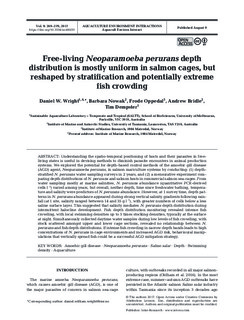| dc.description.abstract | Understanding the spatio-temporal positioning of hosts and their parasites in free-living states is useful in devising methods to diminish parasite encounters in animal production systems. We explored the potential for depth-based control methods of the amoebic gill disease (AGD) agent, Neoparamoeba perurans, in salmon mariculture systems by conducting: (1) depth-stratified N. perurans water sampling surveys in 2 years, and (2) a mensurative experiment comparing depth distributions of N. perurans and salmon hosts in commercial salmon sea-cages. From water sampling mostly at marine salinities, N. perurans abundance (quantitative PCR-derived cells l-1) varied among years, but overall, neither depth, time since freshwater bathing, temperature and salinity were predictors of N. perurans abundance. However, at 1 survey time, depth patterns in N. perurans abundance appeared during strong vertical salinity gradients following rainfall (at 1 site, salinity ranged between 14 and 35 g l-1), with greater numbers of cells below a less saline surface layer. This suggested that salinity mediates N. perurans depth distribution during intermittent halocline development. Fish depth distribution monitoring revealed intense fish crowding, with local swimming densities up to 5 times stocking densities, typically at the surface at night. Simultaneously collected daytime water samples during low levels of fish crowding, with stock scattered amongst upper and lower cage sections, revealed no relationship between N. perurans and fish depth distributions. If intense fish crowding in narrow depth bands leads to high concentrations of N. perurans in cage environments and increased AGD risk, behavioural manipulations that vertically spread fish could be a successful AGD mitigation strategy. | |
